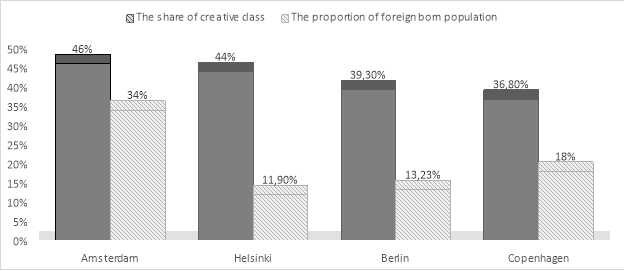This article is based on the “Creative Class” theory of Richard Florida and considers tolerance as one of the most important factors for attracting talented people. Four European capitals are considered from the perspective of such indicators as the proportion of foreign-born population, hospitality and equality rankings. They help to assess the connection between the share of the creative class in the analyzed metropolises and openness of the society.
Keywords: Creative class, Richard Florida, tolerance, European capitals, equality.
Nowadays tolerance is one of the key factors, which attracts talented individuals and contributes to the technological development to the big cities [3, pp. 6–7]. Specifically, the level of diversity and openness to new peoples and cultures has become the important criteria for the creative class. It tends to choose metropolitan areas, where a wide sector of population consists of persons with different backgrounds, world perceptions and values. For this reason, there is a strong connection between the most popular cities among the creative class and the level of tolerance in these places. This is best illustrated through the example of statistics related to 4 famous European capitals. In particular, the share of the creative class in such cities as Amsterdam, Berlin, Copenhagen and Helsinki is more than 36 % of their total population, which is almost the highest rate not only in Europe, but also in the world [5, p. 321]. At the same time, these metropolitan areas are known for their openness and hold top positions in the rankings of tolerance [13]. This key factor of attractiveness, in turn, consists of the number of elements, which make the images of the cities, promoting diversity.
To begin with, such dimension as the number of foreign-born residents should help to analyze the openness of society [4, p.1]. These people with different backgrounds and values make the population more diverse and heterogeneous, which in turn draws original thinkers. For example, Amsterdam as the capital with the largest proportion of the creative class among examined metropolitan areas has 34 % of foreign-born population [8]. At the same time, this figure is several times less in Helsinki, even though it has nearly the same share of original thinkers as in Amsterdam. In particular, according to Eurostat data, only 11.9 % of residents of the capital of Finland were born abroad [1]. However, this ratio is higher in Berlin and amounts to 13.23 %, notwithstanding the smaller share of the creative class residing in the city in comparison with Helsinki [8]. Consequently, these figures confirm that the proportion of foreign-born population alone is not enough to measure openness of the society. The clearest indication of this fact is the statistics relating to the capital of Denmark. Despite Copenhagen has the lowest share of original thinkers among the four reviewed metropolitan areas, it is ahead of Berlin and Helsinki in the number of foreign born population, accounting for 18 % of the total number of its inhabitants [7]. Thus, this example illustrates that attractiveness of the European capitals for the creative class cannot be measured only with the one indicator.

Graph 1. Comparison of the share of the creative class and proportion of foreign-born population
In this connection, it is also important to examine the best cities from a tourism perspective, as the indexes, which are used to carry out the ranking, provide insight into openness of the society. Specifically, the attention is focused on such indicator as safety because it demonstrates the level of tolerance to the people of different cultures. This, in turn, is an important attraction factor for original thinkers, as the population expresses its commitment to supporting diversity. Thus, it explains the reason why Helsinki, which holds third place among the Most Welcoming Cities [12], has such a high share of the creative class, amounting to 44 % of its total number of inhabitants [5, p. 321]. In particular, it is greatly appreciated for its safety, getting 8.78 points out of ten [12]. In contrast, this index level is lower for Berlin and constitutes 6.78. For this reason, the capital of Germany ranked 19th among the Most Welcoming Cities and that therefore has only 39.4 % of original thinkers [5, p. 321]. However, not all the reviewed capitals hold their positions in accordance with the share of the creative class. For example, Amsterdam ranked 52nd among the Most Welcoming Cities, despite the fact that it has the highest proportion of original thinkers in comparison with Berlin, Copenhagen and Helsinki [9]. At the same time the Danish capital, which has the lowest share of the creative class, holds 12th place and gets 9.48 points for its safety [12]. Thus, such difference in evaluation once again demonstrates the necessity of examining several different rankings and their indicators.
In particular, the equality index should also be considered in order to measure the level of tolerance in the metropolitan areas. There are ten different indicators included in this ranking, among which ratio of female to male labor force participation and the level of wheelchair accessibility are especially important. They reflect readiness of the society to accept differences and diversity, which bring so many original thinkers to the cities. The best confirmation of this is the example of Helsinki. It holds first place in the equality index, being highly rated for providing the same opportunities for all individuals regardless their gender and ethnic origin [2]. This explains the large proportion of original thinkers among the residents of the Finnish capital, as 52.3 % of creative jobs are held by women, whose rights are being fully observed [6, p. 4]. At the same time, Amsterdam demonstrates relatively low position in the ranking. Despite it has the highest share of the creative class among the four reviewed metropolitan areas, the capital of the Netherlands holds only 18th place because of the low level of accessibility for handicapped people [2]. For the same reason, Berlin ranked 22nd in the equality index. It is important to notice that the German capital got only 59.5 % for wheelchair mobility [10], although it was awarded as the most accessible city in 2013 [11]. In contrast, Copenhagen, which has the lowest share of the creative class among the analyzed metropolitan areas, is well ahead of Berlin and Amsterdam in the equality ranking. It holds 8th place, being highly evaluated for inclusion of all sexes in the labor market and wheelchair accessibility [2]. Thus, such leading position of Copenhagen in comparison with Berlin and Amsterdam reveals the fact that these indicators of tolerance cannot always reflect the current realities in the issue of the share of the creative class. In this particular case the equality index substantiates the connection between the level of openness and proportion of original thinkers among population only for Helsinki.
Table 1
Ranking of the cities with the creative population according to the indicators of tolerance
|
Ranking by the share of creative class |
Ranking by the proportion of foreign-born population |
Most Welcoming Cities Ranking |
Ranking of the cities based on equality index |
|
|
Amsterdam |
1. (46%) |
1. (34%) |
4. (52 place) |
3. (18 place) |
|
Helsinki |
2. (44 %) |
4. (11.9 %) |
1. (3rd place) |
1. (1st place) |
|
Berlin |
3. (39.4%) |
3. (13.23%) |
3. (19 place) |
4. (22 place) |
|
Copenhagen |
4. (36.8 %) |
2. (18 %) |
2. (12 place) |
2. (8 place) |
As a result, it can be pointed out that all the reviewed capitals hold different places, depending on the used indicators in the rankings. As it is impossible to cover them all, the attention is concentrated on the most important dimensions such as share of foreign-born population, hospitality, and equality indexes. However, even they are only partly successful in determining the most attracting city for the talented people. Namely, table 1 shows that Berlin ranks third among the selected European capitals in terms of the share of the creative class, proportion of foreign-born population and hospitality. However, it takes the fourth place of the four examined metropolises according to the equality index. Amsterdam, for its part, has even less connection between the share of talented people and tolerance indicators. The capital of the Netherlands ranks first among the analyzed metropolises only by share of the creative class and foreign-born population, while it does not take the lead in the Most Welcoming Cities ranking and equality index. In addition, the examples of Helsinki and Copenhagen also demonstrate that the indicators of the society’s openness can be different and tend not to necessarily reflect the proportion of the talented people. That is why, all the examined connections between the number of the creative class in the selected European capitals and such indicators as share of foreign-born population, hospitality and equality confirm the fact that the high level of tolerance is an essential element for original thinkers, but not the only one. And the indexes related to technology and talent deserve the same attention.
References:
1. Cities with the highest proportion of foreign-born inhabitants, 2014 // Eurostat. URL: https://ec.europa.eu/eurostat/statistics-explained/index.php?title=File:Cities_with_the_highest_proportion_of_foreign-born_inhabitants,_2014_(%C2 %B9)_Cities16.png&oldid=294454.
2. Equality in Europe // Spotahome. URL: https://www.spotahome.com/equality-europe-city-ranking.
3. Florida, Richard, 2005, Cities and the Creative Class, New York: Routledge.
4. Florida, Richard and Gates, Gary, ‘Technology and Tolerance: The Importance of Diversity to High-Technology Growth’, The Brookings Institution Survey Series, June, 2001.
5. Florida, Richard and Mellander, Charlotta, 2015, ‘The Rise of the Global Creative Class’, in Daniele Archibugi and Andrea Filippetti, The Handbook of Global Science, Technology, and Innovation, Oxford: Wiley-Blackwell, pp. 313–342.
6. Florida, Richard, Mellander, Charlotta and King, Karen M., 2011, The Rise of Women in the Creative Class, Toronto: Martin Prosperity Institute.
7. Foreign-born inhabitants as a share of total population in 2016 // Nordregio. URL: http://www.nordregio.org/maps/foreign-born-inhabitants-as-a-share-of-total-population-in-2016/.
8. Foreign born population // World Cities Culture Forum. URL: http://www.worldcitiescultureforum.com/data/foreign-born-population.
9. Most welcoming cities — Stockholm and Helsinki tops // Travel Trade Outbound Scandinavia. URL: https://www.ttoscandinavia.com/most-welcoming-cities-stockholm-and-helsinki-tops/.
10. Overall Global Mobility Ranking // Arcadis. URL: https://www.arcadis.com/en/australia/our-perspectives/sustainable-cities-mobility-index-2017/cities/?tf=tab-people&sf=wheelchair_access&r=europe&c=all.
11. Previous winners of the Access City Award // European Commission. URL: http://ec.europa.eu/social/main.jsp?catId=1325&langId=en.
12. Sydney is pretty welcoming, right? Wrong // Travelweekly. URL: https://www.travelweekly.com.au/article/whats-the-worlds-most-welcoming-city/.
13. The Cultural and Creative Cities Monitor // European Commission. URL: https://composite-indicators.jrc.ec.europa.eu/cultural-creative-cities-monitor/createyourmonitor.







